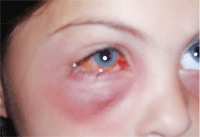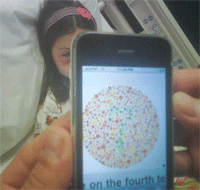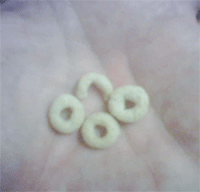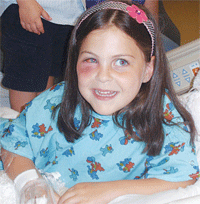When my daughter called one morning to tell me that my granddaughter Leora woke up with difficulty opening her right eye and some discharge at the lid margin, the usual thoughts about conjunctivitis crossed my mind.
“Bring her over,” I said, “and we’ll take a look.”
Leora is five years old, and her mother is a NICU nurse. Leora had been battling a fever the day before but didn’t have any eye or vision problems. Mom gave her some Children’s Tylenol, but in the morning the fever recurred. By the time she arrived at my office, Leora was able to partially open her right eye. While she certainly had blepharitis along her lid margin, inspection of her anterior segment also showed considerable hyperemia and chemosis. Her vision was unaffected, and the remainder of her ocular health and motility exam was normal. Her left eye was totally clear.
I instilled TobraDex (tobramycin/dexamethasone, Alcon) to give her some immediate relief, but Leora’s older sister had just been diagnosed with Streptococcus, and there was clearly something deeper going on. Based on the appearance of her eye, and in consultation with her pediatrician, we started her on Augmentin (amoxicillin/clavulanate potassium, GlaxoSmithKline).
A few hours later, my daughter sent me a cell phone picture of Leora’s eye, which had very quickly become an eye in the midst of a storm.

This photo of my granddaughter’s eye, taken with a cell phone, quickly told me she had a fast-brewing cellulitis.
One look at the photo and I called Leora’s mother: “Go over to the hospital, and I’ll meet you there. Take her to the ER and tell them we have to get her on IV antibiotics as soon as possible. This is a fast-brewing periorbital cellulitis.”
My daughter works part-time at the hospital, so I figured we’d have some pull in getting Leora processed a bit faster. When it’s a loved one at the hospital, time moves at a snail’s pace.
Seeing Leora feverish and her eye glassy in its now fully swollen socket, I flagged the nurse in charge of admissions. “I might be able to sit here patiently as a grandfather, but not as an eye doctor. We really do need to speed up the admissions process.”
As we moved upstairs into Pediatrics, the house pediatrician remarked on Leora’s severe periorbital cellulitis. “The only other time I’ve seen one this bad was in a case associated with MRSA,” she said. Not a comforting thought.
The pediatrician took a thorough history, looked in Leora’s ears, and did externals, including motilities and pupils. When I asked the pediatrician if she would be looking inside Leora’s eye, she said the light would be bright and she didn’t want to make Leora any more uncomfortable. I invited myself to do ophthalmoscopy, welcoming the opportunity to set aside the grandfather within, and thankfully found nothing remarkable.
My granddaughter’s fever had been spiking again, and she had vomited earlier when trying to take anything orally. She had almost as much trouble facing the IV needle. But, when the antibiotics ceftriaxone and nafcillin finally began to course through Leora’s veins, I asked about obtaining a CT scan.
The answer surprised me, given that Leora’s eye had blown up within a few hours to the point where she looked like she’d been in a boxing match. “We generally prefer to wait a day and see how well the child responds to the antibiotics.”
I went out to the parking lot to clear my head and get a better cell phone signal. I called “Joe Nap” (a.k.a., Joseph D. Napolitano, M.D.), the pediatric ophthalmologist at our Omni referral clinic. I sent him a photo, and he replied with what I needed most: reassurance.
“It looks entirely preseptal and symmetrical from the photo, but I’d insist on a CT scan just to get a baseline,” he said. “Call me on my cell any time if you have a question, and I’ll be up there in a heartbeat if you need me.”
The hospital’s pediatrician was not thrilled with Joe’s suggestion. It was 10:30 p.m., and there was no in-house radiologist to read the CT scan.
I suggested, “Let’s get the CT scan done tonight, and the radiologist can always read it first thing in the morning.” The doctor eventually agreed. Fortunately, the CT scan proved negative, with normal optic globes, no evidence of postseptal cellulitis, no abscess and clear paranasal sinuses.
Daybreak thankfully found Leora responding to the IV antibiotics, and her blood workup began to reflect the battle against the infection. Her entering white blood cell count of 24.5 was working its way down to the upper normal range of 15. The eye swab culture wouldn’t be back for a few days, and was unlikely to add anything to the present course of action.
When I arrived at the hospital at 8 a.m., Leora was still being a wonderful patient. Her IV was a bit of a drag, but Leora was becoming fast friends with “Mrs. Machine.”

There’s an app for that: We used an iPhone to test Leora’s color vision.
I continued to check Leora’s eye internally and externally, finding nothing remarkable. Her uncle Dan—who is also my son and a wonderful associate—helped us improvise a bedside test. He pulled out his iPhone and downloaded a series of Ishihara plates that established that her color vision was normal, indicating healthy optic nerve function.

I used Cheerios as a makeshift Landolt “C” acuity test. Her acuity was delicious.
A cup of Cheerios left over from breakfast looked inviting, and I dumped a few in my hand. One of them was broken, mimicking a Landolt “C.” I hadn’t checked Leora’s acuity yet, and it seemed like a fun game to identify which of the four Cheerios was the broken one. Fortunately, Leora thought it was fun as well, and this makeshift test showed that her acuity in her right eye was quite good.
By evening, things were really looking up. The swelling continued to resorb and the subconjunctival hemorrhages were in full retreat. Leora’s normal, cheery personality began to return. I had been updating my pediatric ophthalmologic colleague Joe Nap, and he insisted on driving an hour to the hospital. His visit was reassuring and Leora was engaging, promising to send him a picture together with her twin sister. By the following morning, her smile matched the beautiful sunrise.
Three days into the ordeal, Leora was ready to bid Mrs. Machine adieu and return home. The pediatrician prescribed Keflex (cephalexin, Dista) 250mg four times a day for eight days. Leora had been prescribed a topical fluoroquinolone in the hospital, but it was unnecessary given how nicely her eye was resolving.
Leora is all smiles after the antibiotics took effect and the swelling went down.
Her hospital eye culture results came back negative. This wasn’t surprising in light of the TobraDex and Augmentin she had taken prior to her eye blowing up.

Looking back a month later, there is much to be thankful for. Although we will never know for sure what caused Leora’s preseptal cellulitis, the Streptococcus that was running around her house is a good bet. The speed and severity with which her globe ballooned put her cavernous sinus at risk, and credit is due to my daughter’s cell phone photo for prompting me to be aggressive.
I’m a vision therapy specialist by design, and I’ve learned to value tenets of Eastern medicine for healing. Indeed, there are times when Western medicine fails to address or accord due respect to the influence of the psyche on the soma. But, in other instances, time is of the essence, and nothing substitutes for quick, decisive systemic action. This was one of those times, and my granddaughter and I will look back fondly upon I.V. antibiotics and cellular phone medicine.
Dr. Press is Chair of the Pediatrics and Binocular Vision Committee of the American Optometric Association, and is in private practice specializing in children’s vision in Fair Lawn, N.J.

